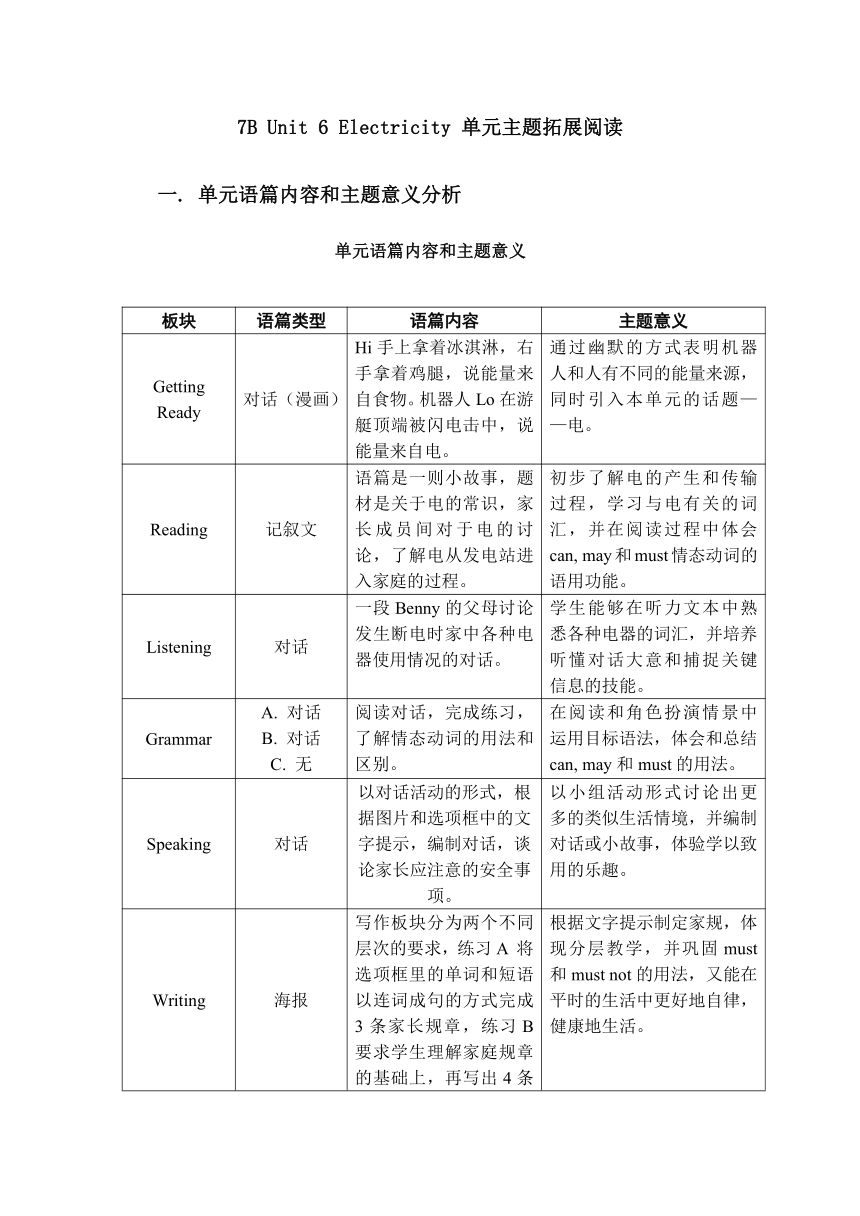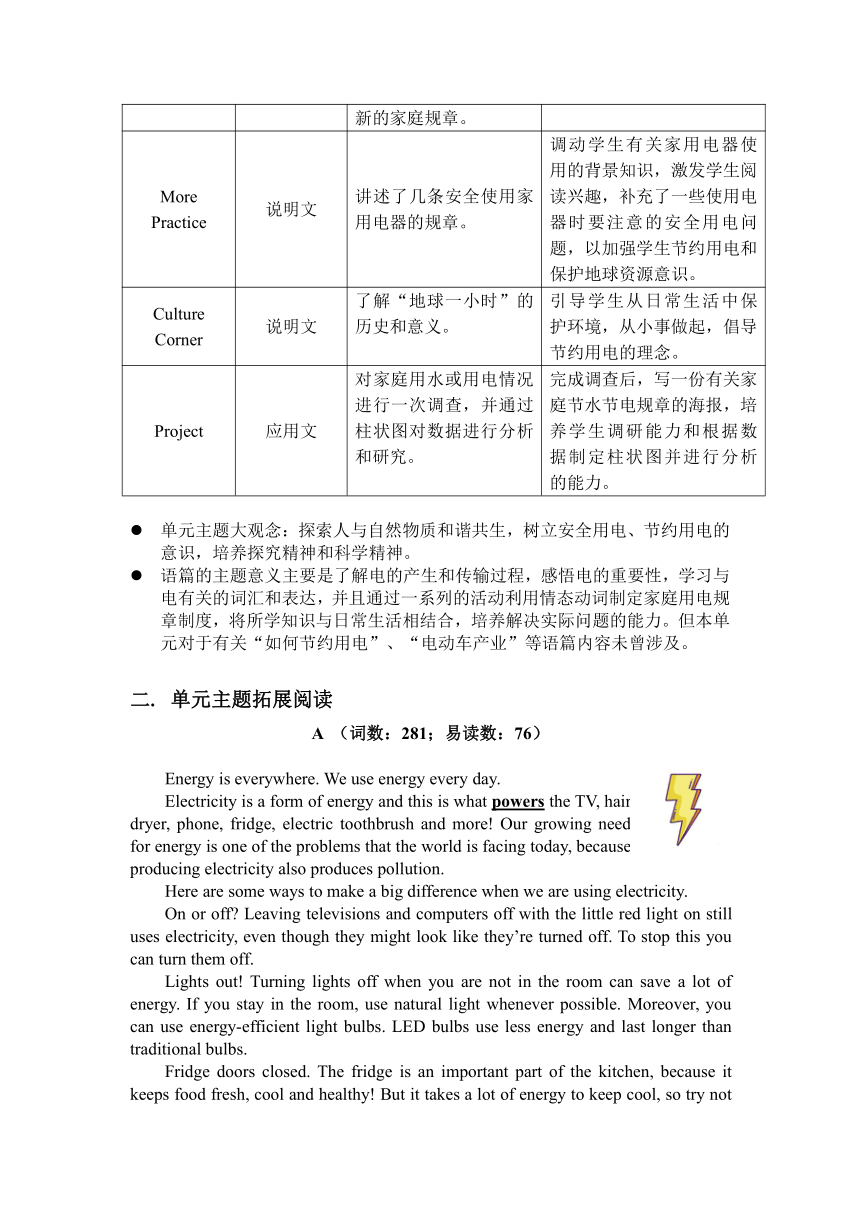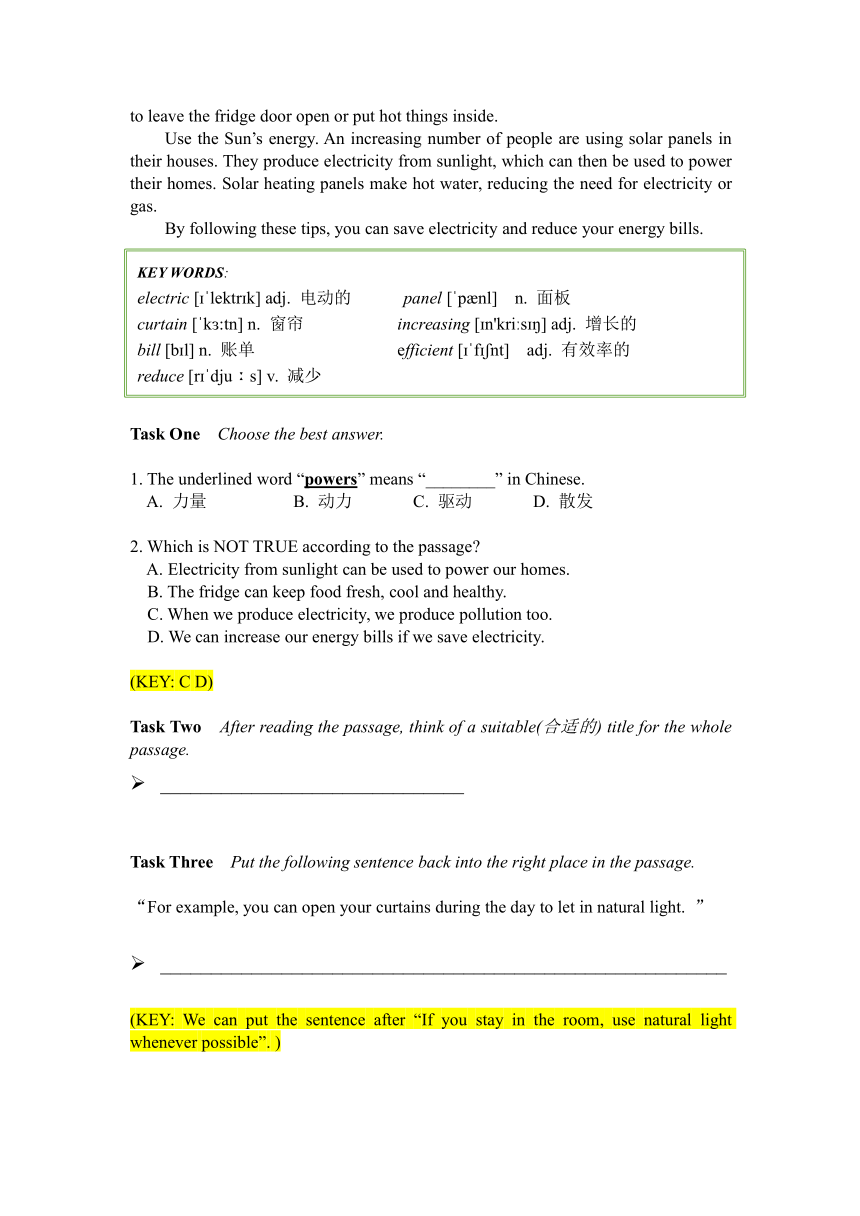Unit 6 Electricity 单元主题拓展阅读 学案2023-2024学年牛津深圳版英语七年级下册
文档属性
| 名称 | Unit 6 Electricity 单元主题拓展阅读 学案2023-2024学年牛津深圳版英语七年级下册 |  | |
| 格式 | docx | ||
| 文件大小 | 938.7KB | ||
| 资源类型 | 教案 | ||
| 版本资源 | 牛津深圳版 | ||
| 科目 | 英语 | ||
| 更新时间 | 2024-05-29 15:24:25 | ||
图片预览



文档简介
7B Unit 6 Electricity 单元主题拓展阅读
一. 单元语篇内容和主题意义分析
单元语篇内容和主题意义
板块 语篇类型 语篇内容 主题意义
Getting Ready 对话(漫画) Hi手上拿着冰淇淋,右手拿着鸡腿,说能量来自食物。机器人Lo在游艇顶端被闪电击中,说能量来自电。 通过幽默的方式表明机器人和人有不同的能量来源,同时引入本单元的话题——电。
Reading 记叙文 语篇是一则小故事,题材是关于电的常识,家长成员间对于电的讨论,了解电从发电站进入家庭的过程。 初步了解电的产生和传输过程,学习与电有关的词汇,并在阅读过程中体会can, may和must情态动词的语用功能。
Listening 对话 一段Benny的父母讨论发生断电时家中各种电器使用情况的对话。 学生能够在听力文本中熟悉各种电器的词汇,并培养听懂对话大意和捕捉关键信息的技能。
Grammar A. 对话 B. 对话 无 阅读对话,完成练习,了解情态动词的用法和区别。 在阅读和角色扮演情景中运用目标语法,体会和总结can, may和must的用法。
Speaking 对话 以对话活动的形式,根据图片和选项框中的文字提示,编制对话,谈论家长应注意的安全事项。 以小组活动形式讨论出更多的类似生活情境,并编制对话或小故事,体验学以致用的乐趣。
Writing 海报 写作板块分为两个不同层次的要求,练习A 将选项框里的单词和短语以连词成句的方式完成3条家长规章,练习B要求学生理解家庭规章的基础上,再写出4条新的家庭规章。 根据文字提示制定家规,体现分层教学,并巩固must 和must not的用法,又能在平时的生活中更好地自律,健康地生活。
More Practice 说明文 讲述了几条安全使用家用电器的规章。 调动学生有关家用电器使用的背景知识,激发学生阅读兴趣,补充了一些使用电器时要注意的安全用电问题,以加强学生节约用电和保护地球资源意识。
Culture Corner 说明文 了解“地球一小时”的历史和意义。 引导学生从日常生活中保护环境,从小事做起,倡导节约用电的理念。
Project 应用文 对家庭用水或用电情况进行一次调查,并通过柱状图对数据进行分析和研究。 完成调查后,写一份有关家庭节水节电规章的海报,培养学生调研能力和根据数据制定柱状图并进行分析的能力。
单元主题大观念:探索人与自然物质和谐共生,树立安全用电、节约用电的意识,培养探究精神和科学精神。
语篇的主题意义主要是了解电的产生和传输过程,感悟电的重要性,学习与电有关的词汇和表达,并且通过一系列的活动利用情态动词制定家庭用电规章制度,将所学知识与日常生活相结合,培养解决实际问题的能力。但本单元对于有关“如何节约用电”、“电动车产业”等语篇内容未曾涉及。
二. 单元主题拓展阅读
A (词数:281;易读数:76)
Energy is everywhere. We use energy every day.
Electricity is a form of energy and this is what powers the TV, hair dryer, phone, fridge, electric toothbrush and more! Our growing need for energy is one of the problems that the world is facing today, because producing electricity also produces pollution.
Here are some ways to make a big difference when we are using electricity.
On or off Leaving televisions and computers off with the little red light on still uses electricity, even though they might look like they’re turned off. To stop this you can turn them off.
Lights out! Turning lights off when you are not in the room can save a lot of energy. If you stay in the room, use natural light whenever possible. Moreover, you can use energy-efficient light bulbs. LED bulbs use less energy and last longer than traditional bulbs.
Fridge doors closed. The fridge is an important part of the kitchen, because it keeps food fresh, cool and healthy! But it takes a lot of energy to keep cool, so try not to leave the fridge door open or put hot things inside.
Use the Sun’s energy. An increasing number of people are using solar panels in their houses. They produce electricity from sunlight, which can then be used to power their homes. Solar heating panels make hot water, reducing the need for electricity or gas.
By following these tips, you can save electricity and reduce your energy bills.
Task One Choose the best answer.
1. The underlined word “powers” means “________” in Chinese.
A. 力量 B. 动力 C. 驱动 D. 散发
2. Which is NOT TRUE according to the passage
A. Electricity from sunlight can be used to power our homes.
B. The fridge can keep food fresh, cool and healthy.
C. When we produce electricity, we produce pollution too.
D. We can increase our energy bills if we save electricity.
(KEY: C D)
Task Two After reading the passage, think of a suitable(合适的) title for the whole passage.
______________________________
Task Three Put the following sentence back into the right place in the passage.
“For example, you can open your curtains during the day to let in natural light. ”
________________________________________________________
(KEY: We can put the sentence after “If you stay in the room, use natural light whenever possible”. )
Task Four
Work in groups. Draw a mind map of saving electricity according to the passage.
Task Five Think and Share.
According to your life experience, could you think of more ways to save electricity in your daily lives
___________________________________________________________ _______________________________________________________________ _______________________________________________________________________________________
B(词数:310;易读数:71)
Cars make our lives more convenient. But they can also be a problem. For example, fossil fuel cars mainly cause air pollution.
To improve the environment, many countries are developing electric vehicles. Among them, China is taking a leading role and has created the world’s largest EV(electric vehicle) market.
Last year, over 40 percent of the 753,000 EVs sold in the world were sold in China, more than twice as many as the number sold in the United States.
“Filling up a fossil fuel car with gasoline is more expensive than charging an electric car,” said Wu Hao, who bought an electric car this year.
As the prices of fuel and oil continue going up, the electric cars will become more and more popular in people’s life. Electric cars are different from normal cars. They work by batteries. The battery affects how far the car can go. An electric car can go from 50 to 250 miles. It costs less than the normal car. According to a report, when a normal car goes a mile, one has to spend about 12 cents on it. But for an electric car, it only needs about two cents. It saves lots of money.
However, there are still some problems. It can be hard to find charging piles and the cars can’t go far before recharged. Hopefully, Some of these problems are being solved. In 2014, China had about 31,000 charging piles. Now China has the world’s largest EV charging network, with more than 167,000 charging piles in total.
Developing EVs is one of many efforts that China has made to cut down pressure on its environment after the government promised to stop increases in carbon dioxide emissions by 2030.
“As China goes, so will the world’s car industry,” The Wall Street Journal said. China has taken a leading role in the world’s electric vehicle industry.
Task One Choose the best answer.
1. Over _______ electric vehicles were sold in China last year.
A. 150,600 B. 167,000 C. 301,200 D. 753,000
2. How does the writer develop the passage
A. By telling stories. B. By following the order of time.
C. By giving examples. D. By making comparison.
(KEY: C C)
Task Two Think and Share.
Find out the facts about electric cars in the passage and its supporting details.
Facts about electric cars: ______________________________________ _______________________________________________________________ _______________________________________________________________ _______________________________________________________________ Supporting details: _____________________________________________ ________________________________________________________________ ________________________________________________________________ ________________________________________________________________
Task Three Think and Share.
Between electric cars and normal cars, which would you prefer Why
_______________________________________________________________ _______________________________________________________________ _______________________________________________________________________________________ _______________________________________________________________________________________ _______________________________________________________________________________________ _______________________________________________________________________________________
Task Four What do you think of using electric bicycles in the take-away business What will you suggest State your opinion and suggestions.
I think ______________________________________________________ _______________________________________________________________ _______________________________________________________________________________________ I suggest that ________________________________________________________________________ _______________________________________________________________________________________ _______________________________________________________________________________________ _______________________________________________________________________________________
一. 单元语篇内容和主题意义分析
单元语篇内容和主题意义
板块 语篇类型 语篇内容 主题意义
Getting Ready 对话(漫画) Hi手上拿着冰淇淋,右手拿着鸡腿,说能量来自食物。机器人Lo在游艇顶端被闪电击中,说能量来自电。 通过幽默的方式表明机器人和人有不同的能量来源,同时引入本单元的话题——电。
Reading 记叙文 语篇是一则小故事,题材是关于电的常识,家长成员间对于电的讨论,了解电从发电站进入家庭的过程。 初步了解电的产生和传输过程,学习与电有关的词汇,并在阅读过程中体会can, may和must情态动词的语用功能。
Listening 对话 一段Benny的父母讨论发生断电时家中各种电器使用情况的对话。 学生能够在听力文本中熟悉各种电器的词汇,并培养听懂对话大意和捕捉关键信息的技能。
Grammar A. 对话 B. 对话 无 阅读对话,完成练习,了解情态动词的用法和区别。 在阅读和角色扮演情景中运用目标语法,体会和总结can, may和must的用法。
Speaking 对话 以对话活动的形式,根据图片和选项框中的文字提示,编制对话,谈论家长应注意的安全事项。 以小组活动形式讨论出更多的类似生活情境,并编制对话或小故事,体验学以致用的乐趣。
Writing 海报 写作板块分为两个不同层次的要求,练习A 将选项框里的单词和短语以连词成句的方式完成3条家长规章,练习B要求学生理解家庭规章的基础上,再写出4条新的家庭规章。 根据文字提示制定家规,体现分层教学,并巩固must 和must not的用法,又能在平时的生活中更好地自律,健康地生活。
More Practice 说明文 讲述了几条安全使用家用电器的规章。 调动学生有关家用电器使用的背景知识,激发学生阅读兴趣,补充了一些使用电器时要注意的安全用电问题,以加强学生节约用电和保护地球资源意识。
Culture Corner 说明文 了解“地球一小时”的历史和意义。 引导学生从日常生活中保护环境,从小事做起,倡导节约用电的理念。
Project 应用文 对家庭用水或用电情况进行一次调查,并通过柱状图对数据进行分析和研究。 完成调查后,写一份有关家庭节水节电规章的海报,培养学生调研能力和根据数据制定柱状图并进行分析的能力。
单元主题大观念:探索人与自然物质和谐共生,树立安全用电、节约用电的意识,培养探究精神和科学精神。
语篇的主题意义主要是了解电的产生和传输过程,感悟电的重要性,学习与电有关的词汇和表达,并且通过一系列的活动利用情态动词制定家庭用电规章制度,将所学知识与日常生活相结合,培养解决实际问题的能力。但本单元对于有关“如何节约用电”、“电动车产业”等语篇内容未曾涉及。
二. 单元主题拓展阅读
A (词数:281;易读数:76)
Energy is everywhere. We use energy every day.
Electricity is a form of energy and this is what powers the TV, hair dryer, phone, fridge, electric toothbrush and more! Our growing need for energy is one of the problems that the world is facing today, because producing electricity also produces pollution.
Here are some ways to make a big difference when we are using electricity.
On or off Leaving televisions and computers off with the little red light on still uses electricity, even though they might look like they’re turned off. To stop this you can turn them off.
Lights out! Turning lights off when you are not in the room can save a lot of energy. If you stay in the room, use natural light whenever possible. Moreover, you can use energy-efficient light bulbs. LED bulbs use less energy and last longer than traditional bulbs.
Fridge doors closed. The fridge is an important part of the kitchen, because it keeps food fresh, cool and healthy! But it takes a lot of energy to keep cool, so try not to leave the fridge door open or put hot things inside.
Use the Sun’s energy. An increasing number of people are using solar panels in their houses. They produce electricity from sunlight, which can then be used to power their homes. Solar heating panels make hot water, reducing the need for electricity or gas.
By following these tips, you can save electricity and reduce your energy bills.
Task One Choose the best answer.
1. The underlined word “powers” means “________” in Chinese.
A. 力量 B. 动力 C. 驱动 D. 散发
2. Which is NOT TRUE according to the passage
A. Electricity from sunlight can be used to power our homes.
B. The fridge can keep food fresh, cool and healthy.
C. When we produce electricity, we produce pollution too.
D. We can increase our energy bills if we save electricity.
(KEY: C D)
Task Two After reading the passage, think of a suitable(合适的) title for the whole passage.
______________________________
Task Three Put the following sentence back into the right place in the passage.
“For example, you can open your curtains during the day to let in natural light. ”
________________________________________________________
(KEY: We can put the sentence after “If you stay in the room, use natural light whenever possible”. )
Task Four
Work in groups. Draw a mind map of saving electricity according to the passage.
Task Five Think and Share.
According to your life experience, could you think of more ways to save electricity in your daily lives
___________________________________________________________ _______________________________________________________________ _______________________________________________________________________________________
B(词数:310;易读数:71)
Cars make our lives more convenient. But they can also be a problem. For example, fossil fuel cars mainly cause air pollution.
To improve the environment, many countries are developing electric vehicles. Among them, China is taking a leading role and has created the world’s largest EV(electric vehicle) market.
Last year, over 40 percent of the 753,000 EVs sold in the world were sold in China, more than twice as many as the number sold in the United States.
“Filling up a fossil fuel car with gasoline is more expensive than charging an electric car,” said Wu Hao, who bought an electric car this year.
As the prices of fuel and oil continue going up, the electric cars will become more and more popular in people’s life. Electric cars are different from normal cars. They work by batteries. The battery affects how far the car can go. An electric car can go from 50 to 250 miles. It costs less than the normal car. According to a report, when a normal car goes a mile, one has to spend about 12 cents on it. But for an electric car, it only needs about two cents. It saves lots of money.
However, there are still some problems. It can be hard to find charging piles and the cars can’t go far before recharged. Hopefully, Some of these problems are being solved. In 2014, China had about 31,000 charging piles. Now China has the world’s largest EV charging network, with more than 167,000 charging piles in total.
Developing EVs is one of many efforts that China has made to cut down pressure on its environment after the government promised to stop increases in carbon dioxide emissions by 2030.
“As China goes, so will the world’s car industry,” The Wall Street Journal said. China has taken a leading role in the world’s electric vehicle industry.
Task One Choose the best answer.
1. Over _______ electric vehicles were sold in China last year.
A. 150,600 B. 167,000 C. 301,200 D. 753,000
2. How does the writer develop the passage
A. By telling stories. B. By following the order of time.
C. By giving examples. D. By making comparison.
(KEY: C C)
Task Two Think and Share.
Find out the facts about electric cars in the passage and its supporting details.
Facts about electric cars: ______________________________________ _______________________________________________________________ _______________________________________________________________ _______________________________________________________________ Supporting details: _____________________________________________ ________________________________________________________________ ________________________________________________________________ ________________________________________________________________
Task Three Think and Share.
Between electric cars and normal cars, which would you prefer Why
_______________________________________________________________ _______________________________________________________________ _______________________________________________________________________________________ _______________________________________________________________________________________ _______________________________________________________________________________________ _______________________________________________________________________________________
Task Four What do you think of using electric bicycles in the take-away business What will you suggest State your opinion and suggestions.
I think ______________________________________________________ _______________________________________________________________ _______________________________________________________________________________________ I suggest that ________________________________________________________________________ _______________________________________________________________________________________ _______________________________________________________________________________________ _______________________________________________________________________________________
